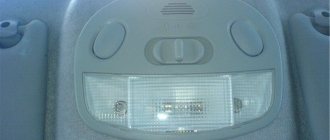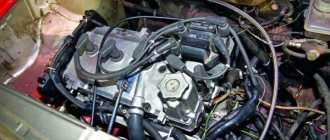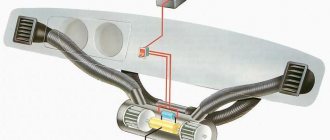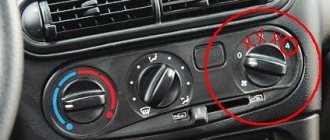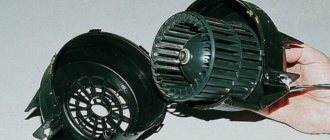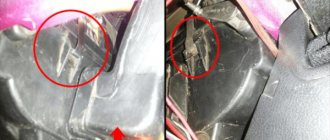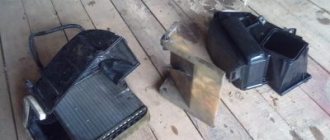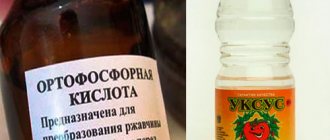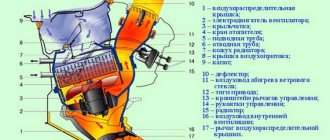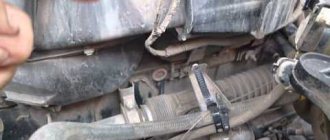Today there are quite a few ways to clean a radiator from contaminants. There are serious doubts about the feasibility of some of them: the ingredients are difficult to obtain, and the cleaning process itself is quite labor-intensive. Therefore, it is better to choose those methods where the risk of damaging the car is minimal and there is no threat to your own health. And remember, you do all the work at your own peril and risk. If you want to get the perfect result, get a guarantee for the services provided and be sure that everything is done correctly, use the services of our car service. Make an appointment by phone +7-383-310-39-17 or follow the link: :
Cleaning the stove without removing it
Methods for flushing the stove radiator without removal and with removal: choosing the most effective
The warmth in the car interior is not a whim at all, but a guarantee of pleasant and safe driving. Frost that forms on the glass in cold weather interferes with full visibility on the road and increases the risk of an accident. After all, with the arrival of autumn, sharp temperature changes begin between daytime and nighttime. And if the stove blows cold air or doesn’t work at all, then it’s time to clean the radiator. It is important not to delay until the last minute, but to check the operation of the stove in advance and, if necessary, eliminate all malfunctions. The heating principle is the same for all cars. Antifreeze circulates through the system, gradually heating up to a high temperature. Hot air enters the cabin using an electric motor, which is located next to the heater radiator. Gradually, plaque accumulates inside the radiator tubes. This is reminiscent of the scale that forms in teapots. The heat transfer of the stove decreases and the quality of heating inside the machine naturally deteriorates. If the thermostat and heater fan are working properly, the air ducts are not clogged with dirt, the antifreeze content is within normal limits and the system is not air-filled, then the cause of the cold inside the car is a dirty heater radiator.
Contaminants “wander” through the cooling system, slowly settling in the radiator cells. In the absence of systematic car care, car parts are subject to corrosion. Scale deposits, particles from antifreeze evaporation accumulate on the metal, and greasy oil stains appear. We are, of course, talking about cars that have been in use for at least 2 years. It is recommended to flush the cooling system once every two to three years, depending on the conditions of use of the car. For example, cars that drive on rural roads or heavily dusty areas require more maintenance. In addition, washing with caustic compounds must be carried out with gloves to avoid thermal or chemical burns. The concentration of ingredients selected “by eye” leads to excessive consumption of cleaning products, and sometimes to damage to parts. Under no circumstances should you “forget” the radiator in the solution for an indefinite period. Also, do not neglect flushing the cooling system with distilled water. And use only high-quality antifreeze. In cold weather, experts do not recommend cleaning the radiator at home. There may be frost at night, and there may be some liquid left in your car. It is better to carry out all work in special boxes or insulated rooms. The ideal option is a car service, where qualified specialists will independently carry out the necessary operations.
Step by step procedure
At home, the easiest way is not to remove the radiator before cleaning it. This method of cleaning the cooling system is much simpler and no less effective than the dismantling method. The process takes place in several stages and consists of a thorough rinsing with water to remove accumulated dirt and a final rinsing using chemicals:
- The old antifreeze is drained.
- Using special hoses with nozzles, hot water is poured into the machine and then released. The process is continued until the flowing stream is as clean as possible.
- The selected cleaning liquid should be poured through the hose into the radiator until the stove is completely filled and then shut off both hoses.
- The holding time of the composition ranges from half an hour to 2 hours, depending on the selected solution. As for specialized cleaners, the period of their optimal effect is described in the instructions for use.
- Next, you need to drain the solution and rinse the heat exchange system with clean water.
- At the final stage, you need to fill in fresh antifreeze.
The water is drained until it becomes clear.
If the operation of the stove does not improve after this method, it is most likely out of order and needs to be replaced with a new one.
Cleaning the stove radiator without removing it
There are several methods for flushing the heater radiator that do not involve dismantling. In this case, cleaning the car’s cooling system is not the most difficult process, but its timely implementation will help eliminate unnecessary problems and discomfort when driving in the cool season. It is worth choosing a suitable cleaning method based on the material from which the heat exchanger is constructed. For example, you cannot wash a radiator made of aluminum with alkaline solutions. Conversely, solutions containing acid should not be used when working with copper and brass parts. To clean the radiator, you can use both improvised and professional means. Also, you should absolutely not carry out the procedure for cleaning the heater radiator when it is cold outside.
Symptoms of malfunction
Cold air from the deflectors when the coolant is at operating temperature and the heating is on indicates that the heating system is operating in emergency mode. Determining the cause of the malfunction is easy. There can only be two options here: either the heater tap is broken, or its radiator is clogged. In both cases the symptoms are the same. The incoming radiator pipe will be hot, the outgoing pipe will be cold. But how can you accurately identify the problem?
And there is nothing complicated here. If the faucet drive cable is intact, but the faucet itself works normally and does not leak, then the problem is in the radiator. You can, of course, go to a service station and have it replaced. This option is much simpler than flushing the car heater radiator yourself, but it is more expensive. But why waste money if the situation can be corrected without buying a new spare part.
Cleaning with citric acid.
One of the cheapest and most accessible methods of descaling. The rinsing solution is easy to make yourself. It is necessary to dissolve 200 g of acid in warm distilled water. Sometimes it is recommended to add a little vinegar. The resulting liquid must be heated. After this, you will need to drain the old antifreeze and add flushing fluid. Next, we take a break and use the car as usual. After 3-4 days, drain the liquid, which should remove all dirt and scale particles. After that, fill in the antifreeze and the work is finished.
Ease: 5
Cost: 5Time spent: 3Quality: 5Bottom line: recommended for moderate soiling.
Rinsing with Fanta, Schweppes or Sprite.
This method is also recommended by experienced car owners.
It is important not to confuse sodas, since Fanta, Schweppes and Sprite contain citric acid, and, for example, Coca-Cola contains orthophosphoric acid, which can damage the metal surface. You need to purchase 6-8 liters of soda, ideally without bright colors, and then flush the cooling system. After completing the procedure, make sure that as much liquid as possible has been drained. Then you need to rinse the parts twice with water and add antifreeze. Simplicity: 3
Cost: 2 Time spent: 5 Quality: 3 Result: recommended for moderate contamination.
Washing methods
There are two ways to clean the heater: by removing it from the car and without removing it. Each method has its own advantages and disadvantages. In the first case, the radiator is dismantled along with the tap. This makes it possible to assess the condition of these components of the cooling system, as well as get rid of dust and dirt on the heater lamellas. However, this method is not suitable for everyone, since before flushing the stove radiator, it will take a long and tedious time to remove it, and then install it. In some cars, to get to the heater, you even need to disassemble the dashboard. If you don’t particularly want to do this, you can clean it without dismantling it. If cleaning is performed correctly, its effectiveness will be the same in both cases.
Cleaning with lactic acid.
This method can give good results, but you won't find lactic acid in the supermarket.
Offers for sale are sometimes found on auto forums. Usually 36% acid is sold, but for cleaning you need 6%. Therefore, dilute the acid in a ratio of 1:5 in distilled water. Fill and wait until the formation of carbon dioxide stops. Then you need to drain the dirty liquid.
There are car enthusiasts who prefer to drive their car for several kilometers and only then drain the flushing fluid. However, be careful - despite the fact that this solution is not so aggressive on aluminum parts, the engine can become very hot. And, most importantly, do not forget to neutralize the acid by rinsing the parts with distilled water. The engine should run for about 15 minutes. Only after this can you add antifreeze.
Simplicity: 5
Cost: 4 Time spent: 5 Quality: 4 Result: recommended for moderate to high levels of contamination.
We clean the heater without dismantling it
How to flush the heater radiator without removing it from the car? It would seem that this process is quite complex and time-consuming, but in reality everything is not so complicated. First, you need to place the car on a pit or overpass, and drain all the coolant from the system. Before doing this, it is advisable to warm up the engine to operating temperature. This will allow the coolant to drain faster. After this, you need to disconnect the hoses from the inlet and outlet pipes of the radiator by loosening the clamps with a screwdriver.
Now we need two hoses, which will need to be connected to the nozzles in the same way. Before rinsing the car heater radiator with a pre-prepared or purchased product, it is advisable to rinse it with plain water. This solution will allow you to get rid of soft dirt that has not yet had time to be deposited on the walls.
Naturally, you need to rinse with running water. To do this, connect one hose to the radiator inlet and another to the outlet. Apply water to the first one. Flush the heater for at least 5-7 minutes.
Only after this can you start pouring the cleaning agent. Having previously closed the outlet pipe, pour the solution into the radiator until it is completely filled. Now give the heater some time to allow the dirt to dry out. After a few hours, the liquid must be drained and the stove rinsed again with running water.
Washing with whey.
An old folk remedy that was used back in Soviet times.
The serum helps dissolve scale and rust. However, if the stains are too old, the serum will soften them, but will not completely eliminate them. You need to drain the coolant, then pour in two or three liters of whey, strained through cheesecloth. You need to use the machine for a couple of days. After this, it is necessary to drain the serum and rinse the system with water. Some car enthusiasts note that even after thorough flushing, foam forms in the cooling system. Simplicity: 5
Cost: 4 Time spent: 4 Quality: 4 Summary: Recommended for small to medium-sized stains.
Washing with acetic acid
You will need three bottles of food vinegar (70%).
They are sold in almost every supermarket. Also, don't forget to drain the old antifreeze. Remove the pipes leading to the heater radiator. After this, you need to use a compressor to blow out the remaining antifreeze and rinse the radiator with water. After drying, you need to pour vinegar into it and leave for about an hour. Then thoroughly flush the radiator fluid. To understand what the result of the procedure is, it is better to drain the water into a bucket. The older your “iron horse” is, the more obvious the result. The radiator will need to be blown out and dried again. Now you need to attach the pipes back, fill in antifreeze and start the engine. Simplicity: 5
Cost: 5 Time spent: 4 Quality: 5 Summary: recommended for moderate contamination.
Flushing the radiator with complete removal
Dismantling a stove radiator is a labor-intensive process that requires good knowledge of the machine's structure. But in some cases this cannot be avoided. Car enthusiasts who do not have experience in successfully removing a radiator are better off seeking professional help. Ideally, it is better to contact a car service.
Flushing with complete removal is indicated in cases where methods of cleaning the radiator without dismantling have shown to be ineffective.
Removing the heater core will allow you to identify several types of faults at once. For example, in this way you can test the operation of the fan and, if necessary, replace its motor.
Also, during dismantling, it will be possible to thoroughly rinse and clean the heater radiator from the outside. In cars without a filter, a lot of debris and dust accumulates in the air intake. Poplar fluff is extremely dangerous, as it bakes and forms a thick crust. The result is a dirty heat exchanger that is poorly ventilated and generates heat.
It is possible to understand the condition of the pipes, assess the degree of contamination of the radiator cells and the tightness of the seal when closing the air duct dampers only by removing the radiator. The drive of the dampers and the voids in the closed position between them and the stove cause air to enter from the outside, allowing the radiator to pass through. This can happen to both budget cars and expensive foreign cars. And in this case, you definitely shouldn’t experiment with disassembling your car.
Dismantling the heater radiator will allow you to objectively assess the quality of the cooling system. If the radiator does not work, cleaning is absolutely pointless - a complete replacement of the cooling system elements is necessary. Contamination of the cooling system does not occur immediately; dirt accumulates gradually. But the moment when the radiator begins to leak and becomes clogged to the point of complete failure is always an unpleasant surprise. If it is made of a copper alloy, then the issue can be solved with small means - remove the radiator and solder it. If the aluminum radiator is faulty, it is easier to replace it. The cost of repair will most likely be equal to the price of the radiator.
To wash with removal, you do not need to use a pump. You need good pressure of hot water in a special bathroom. During dismantling, they use the entire arsenal of both homemade and professional means for flushing the stove radiator. But there are methods that can only be used by removing the radiator. At home, they pose a health hazard and are too labor-intensive.
How to clean the stove in a car
With the onset of the first cold weather, the car owner may be in for an unpleasant surprise - the heater heats up very weakly. The most common reason for this is contamination of the stove radiator. How to wash it?
Bath in a car service after flushing the heater radiator on a VAZ-2112
The heater radiator in a car, as a rule, becomes clogged in several cases. Firstly, the use of low-quality coolant leads to the appearance of deposits in the radiator channels. Secondly, again, due to poor antifreeze or antifreeze, the radiator may become rusty from the inside. And finally, the most insidious reason is the use of bulk sealant for the cooling system. Often it closes not only the leak site, but also other bottlenecks, such as the radiator channels of the same stove.
There are two ways to flush the stove: directly on the car and by removing the radiator.
How to flush the heater radiator in a car without removing
Removing a heater core from a car is quite difficult. In modern cars, this will require disassembling many structures, so many car owners are primarily interested in how to wash the stove directly on the car. Such technology exists.
Flushing the stove on a car, in principle, is no different from the same operation with removing the radiator. The only point is that certain conditions are required. The point of flushing in both cases is to drive a certain solution through the radiator that can dissolve deposits and wash them out.
Heater radiator Lada Granta
To do this, you need to disconnect the inlet and outlet pipes from the heater radiator under the hood and connect your own instead. What kind of “your own pipes” these will be depends on your capabilities. Ideally, if you have a garage and a water pump with low pressure, you can organize a whole stand for cleaning the stove. However, this is not available to everyone, so many car owners use a simple but effective method.
We take two one and a half buckets and pour the solution into one of them. Now we put hoses on the necks of the bottles with a diameter suitable for the radiator fittings (the same diameter as on the standard pipes), and pull them onto these fittings. Now, by pressing on the bottle filled with solution, you will drive the contents inside the radiator.
The volume of most radiators in passenger car heaters is such that one and a half liters is enough. The liquid will pass through the radiator and exit into the second, empty bottle. If there is not enough solution, it can be added. It is necessary to ensure that the bottles are filled approximately halfway, and at the same time the solution passes through the stove radiator.
Now, alternately pressing one and a half, we drive the solution through the radiator. The pressure created in this case is, of course, small. Therefore, this method is unlikely to be suitable for serious blockages, but in most cases such flushing is sufficient. Of course, it wouldn’t hurt to let this “system” just sit idle for at least an hour. Then the solution inside the radiator will better corrode the deposits and they can be expelled into the same bottles.
Flushing the heater radiator with removal
As mentioned above, washing with the “bottle” method will not help with all stains. In some cases, there may simply not be enough pressure. For wider possibilities, the stove radiator still needs to be removed. How to do this, you need to find out from the instructions for a specific car. And then the removed radiator can be washed as desired! The most common method is to flush the house under the tap.
Washing with sulfuric acid
Dismantling in this case is mandatory to avoid damage to the rubber and plastic parts of the cooling system. In today's conditions, this is a rather exotic method, the feasibility of which is highly doubtful. Before starting the procedure, you must follow all safety regulations. It is imperative to protect your eyes with special glasses and the skin of your hands with rubber gloves. It would be a good idea to throw a special robe over your clothes. In addition, use a household respirator that will protect your respiratory tract from toxic fumes. Also use special tongs or grips to prevent direct contact with the solution. In addition, you will need a hydrometer to measure the concentration of the wash liquid. Please note that rinsing requires a 15% acid solution. Therefore, the hydrometer should show a density of 1.1 grams per 1 cubic centimeter. To obtain the solution you also need distilled water and battery electrolyte. It is important to remember that you should never pour water into acid.
On the contrary, you need to carefully add the acid to the water. Old-style radiators made of copper can be washed in a similar way. Parts made of aluminum and zinc, on the contrary, will become unusable.
Simplicity: 1
Cost: 3 Time spent: 4 Quality: 5 Result: recommended in case of high levels of contamination.
Cleaning with hydrochloric acid solution
Another dangerous method that is not recommended without similar practical experience.
In addition, hydrochloric acid is quite difficult to obtain. Compliance with safety precautions, as in the case of using sulfuric acid, is simply mandatory. When using acid to get rid of heavy contaminants, you need to fill the cooling system with a 2% acid solution. You will need no more than 50 ml per 1 liter of water. After flushing the heating system, you need to carefully rinse it with water several times. Never use this method if the cooling system consists of parts susceptible to corrosion.
Simplicity: 1
Cost: 3 Time spent: 4 Quality: 5 Result: recommended in case of high levels of contamination.
How can this be done
Before you start cleaning the radiator, you should know the properties of the material from which it is made. Alkaline-based cleaners are not suitable for an aluminum heat exchanger. Wash it with concentrated, undiluted acid, since the use of water can disrupt the corrosion protection of the surface.
Acid can damage copper or brass radiators. It is good to clean such material using soda and other alkaline compounds.
Severely clogged radiator = inoperative heater
Specialty chemistry
The stores sell a fairly extensive range of specialized chemicals. Among them are:
- FELIX cleaner;
- safe complex composition Radiator Flush Complete;
- for complex stains Radiator Flush 2×1 from the Russian manufacturer Lavr;
- foreign product Hi-Gear.
Experts recommend using special.
products When using such products, there are no problems with proportions; they are as safe as possible for car parts. To achieve the desired result, you should strictly follow the instructions for use of the cleaners.
Home methods
Among available means, many motorists prefer citric acid, household chemicals like Anti-Scalp, Mole or even Coca-Cola. For copper radiators, use caustic soda or any alkaline solution.
The use of household and improvised means requires special care. It is important to know the proportions in which to breed them. They usually require adding a lot of water.
If there is not a lot of dirt, citric acid can help
Coke or Fanta contains a lot of sugar, which can damage engine performance, so they should be consumed with caution.
The equipment required is simple: two hoses and a container
You can gently and safely clean aluminum parts and remove dirt using whey (600 g of lactic acid diluted in 10 liters of water) or highly diluted oxalic acid.
